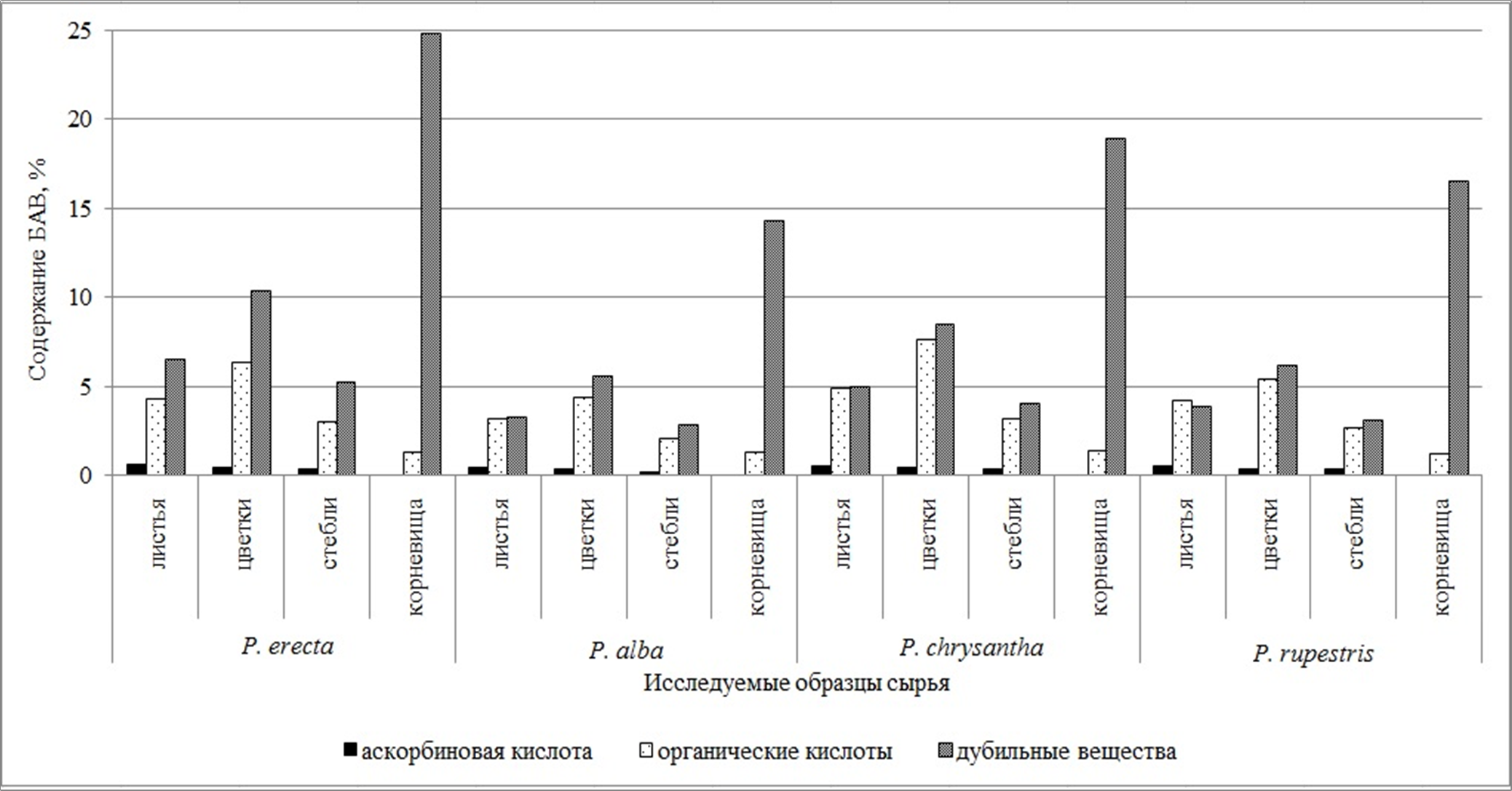БИОХИМИЧЕСКИЙ СОСТАВ СЫРЬЯ НЕКОТОРЫХ ПРЕДСТАВИТЕЛЕЙ РОДА POTENTILLA L. КОЛЛЕКЦИИ ЮЖНО-УРАЛЬСКОГО БОТАНИЧЕСКОГО САДА-ИНСТИТУТА УФИЦ РАН
УДК 582.734.3:581.6
Аннотация
Род лапчатка (Potentilla L.) – самый обширный род семейства Розоцветные (Rosaceae). Лапчатки встречаются во всех экологических нишах: на открытых каменистых склонах, по берегам рек, на опушках лесов. При этом помимо фармакопейного вида – лапчатки прямостоячей (P. erecta L.) – в настоящее время научный интерес вызывают и другие виды рода Potentilla L., так как тоже содержат широкий спектр биологически активных соединений, что обусловливает их фармакологический эффект. Целью работы являлось сравнительное изучение химического состава надземной и подземной частей некоторых представителей рода Potentilla L., интродуцированных в условиях Южно-Уральского ботанического сада-института УФИЦ РАН.
Качественные реакции позволили определить присутствие аскорбиновой кислоты и дубильных веществ в исследуемом сырье. Тонкослойная хроматография установила наличие щавелевой (Rf=0.14), винной (Rf=0.36), лимонной (Rf=0.39), аскорбиновой (Rf=0.62) и яблочной кислот (Rf=0.80). В результате количественного анализа сырья четырех представителей рода Potentilla L. (P. erecta, P. alba, P. rupestris, P. chrysantha) выявлено, что максимальное накопление аскорбиновой кислоты отмечается в листьях (0.47–0.64%), органических кислот – в цветках (4.32–6.28%), дубильных веществ – в корнях (14.25–24.78%). Несмотря на то, что показатели накопления некоторых групп биологических активных веществ в фармокопейном виде (P. erecta) выше, чем у исследованных таксонов, лапчатки P. alba, P. chrysantha, P. rupestris также содержат значительное количество биологически активных веществ и представляют интерес для дальнейшего их изучения.
Скачивания
Metrics
Литература
Tikhomirova L.I., Bazarnova N.G., Sysoyeva A.V., Shcherbakova L.V. Khimiya rastitel'nogo syr'ya, 2018, no. 1, pp. 145–154. DOI: 10.14258/jcprm/2018012734. (in Russ.).
Maxmudova M.M. International Research Journal, 2022, no. 1-2(115), pp. 31–33. DOI: 10.23670/IRJ.2022.115.1.045.
Reut A.A., Shigapov Z.Kh. Problemy botaniki: istoriya i sovremennost': materialy Mezhdunarodnoy nauchnoy kon-ferentsii. [Problems of Botany: History and Modernity: Proceedings of the International Scientific Conference]. Voro-nezh, 2020, pp. 316–320. (in Russ.).
Motorykina T.N. Regional'nyye problemy, 2018, vol. 21, no. 2, pp. 113–117. (in Russ.).
Motorykina T.N. Regional'nyye problemy, 2019, vol. 22, no. 4, pp. 30–36. DOI: 10.31433/2618-9593-2019-22-4-30-36. (in Russ.).
Fedorova A.Yu., Yefremova L.P. Mezhdunarodnyy zhurnal gumanitarnykh i yestestvennykh nauk, 2020, no. 1-1(40), pp. 30–32. DOI: 10.24411/2500-1000-2020-10008. (in Russ.).
Kucherov Ye.V., Lazareva D.N. Tselebnyye rasteniya i ikh primeneniye. [Healing plants and their uses]. Ufa, 1993, 287 p. (in Russ.).
Korsun V.F., Pupykina K.A., Korsun Ye.V. Lekarstvennyye rasteniya v gastroenterologii. Rukovodstvo po klinich-eskoy fitoterapii. [Medicinal plants in gastroenterology. Guide to Clinical Phytotherapy]. Moscow, 2008, 128 p. (in Russ.).
Rastitel'nyye resursy Rossii: Dikorastushchiye tsvetkovyye rasteniya, ikh komponentnyy sostav i biologicheskaya ak-tivnost' [Plant resources of Russia: Wild flowering plants, their component composition and biological activity], ed. A.L. Budantsev. St. Petersburg; Moscow, 2009, vol. 2, 513 p. (in Russ.).
Yakubov V.V. Sosudistyye rasteniya sovetskogo Dal'nego Vostoka. [Vascular plants of the Soviet Far East]. St. Pe-tersburg, 1996, pp. 168–206. (in Russ.).
Tomczyk M., Latte K.P. Journal of Ethnopharmacology, 2009, vol. 122, pp. 184–204.
Khisyamova D.M. Sravnitel'noye farmakognosticheskoye issledovaniye nekotorykh predstaviteley roda lapchatka (Po-tentilla L.): avtoref. diss. … kand. farm. nauk. [Comparative pharmacognostic study of some representatives of the ge-nus Potentilla L.: Abstract of the thesis. diss. … cand. farm. Sciences]. Samara, 2017, 22 p. (in Russ.).
Denisova S.G., Reut A.A. Novyye i netraditsionnyye rasteniya i perspektivy ikh ispol'zovaniya, 2018, no. 13, pp. 32–36. (in Russ.).
The Plant List. URL: http://www.theplantlist.org/.
Kurkin V.A. Farmakognoziya: uchebnik dlya studentov farmatsevticheskikh vuzov. [Pharmacognosy: a textbook for students of pharmaceutical universities]. Samara, 2004, 1180 p. (in Russ.).
Tolmachev A.I. Arealy rasteniy flory SSSR. [Areas of plants of the flora of the USSR]. Leningrad, 1969, vol. 2, 247 p. (in Russ.).
Cherepanov S.K. Svod dopolneniy i izmeneniy k «Flore SSSR» (t. 1–30). [Code of additions and changes to the "Flora of the USSR" (vols. 1-30)]. Leningrad, 1973, 668 p. (in Russ.).
eFlora.org. URL: http://www.efloras.org/florataxon.aspx?flora_id=2&taxon_id=200011124.
Alekseyev Yu.Ye., Galeyeva A.Kh., Gubanov I.A. i dr. Opredelitel' vysshikh rasteniy Bashkirskoy ASSR. [Determinant of higher plants of the Bashkir ASSR]. Moscow, 1989, 375 p. (in Russ.).
Gosudarstvennaya Farmakopeya Rossiyskoy Federatsii, XIV izd. [State Pharmacopoeia of the Russian Federation, XIV ed.]. Moscow, 2018, vol. 2, pp. 2365–2369. (in Russ.).
Gosudarstvennaya Farmakopeya Rossiyskoy Federatsii, XIV izd. [State Pharmacopoeia of the Russian Federation, XIV ed.]. Moscow, 2018, vol. 4, pp. 6622–6633. (in Russ.).
Gosudarstvennaya Farmakopeya Rossiyskoy Federatsii, XIV izd. [State Pharmacopoeia of the Russian Federation, XIV ed.]. Moscow, 2018, vol. 1, pp. 289–318. (in Russ.).
Sviridenko V.G., Khadanovich A.V., Lysenkova A.V., Filippova V.A. Problemy zdorov'ya i ekologii, 2012, no. 3 (33), pp. 137–142. (in Russ.).

Copyright (c) 2023 Химия растительного сырья

Это произведение доступно по лицензии Creative Commons «Attribution» («Атрибуция») 4.0 Всемирная.

This work is licensed under a Creative Commons Attribution 4.0 International License.
Авторы, которые публикуются в данном журнале, соглашаются со следующими условиями:
1. Авторы сохраняют за собой авторские права на работу и передают журналу право первой публикации вместе с работой, одновременно лицензируя ее на условиях Creative Commons Attribution License, которая позволяет другим распространять данную работу с обязательным указанием авторства данной работы и ссылкой на оригинальную публикацию в этом журнале.
2. Авторы сохраняют право заключать отдельные, дополнительные контрактные соглашения на неэксклюзивное распространение версии работы, опубликованной этим журналом (например, разместить ее в университетском хранилище или опубликовать ее в книге), со ссылкой на оригинальную публикацию в этом журнале.
3. Авторам разрешается размещать их работу в сети Интернет (например, в университетском хранилище или на их персональном веб-сайте) до и во время процесса рассмотрения ее данным журналом, так как это может привести к продуктивному обсуждению, а также к большему количеству ссылок на данную опубликованную работу.











